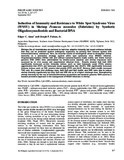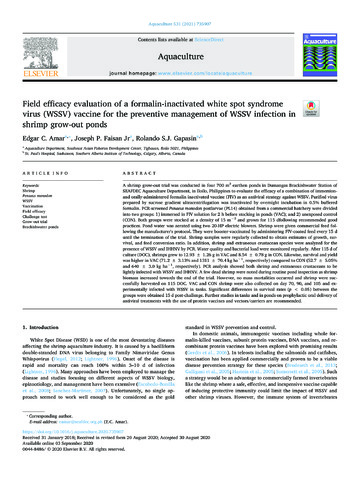| dc.contributor.author | de la Peña, Leobert D. | |
| dc.contributor.author | Caber, Dieyna B. | |
| dc.contributor.author | Villacastin, Anne Jinky B. | |
| dc.contributor.author | Cabillon, Nikko Alvin R. | |
| dc.contributor.author | Arboleda, Joey I. | |
| dc.contributor.author | Castellano, Jose Louis A. | |
| dc.contributor.author | Nava, Joseph Keith Paulo | |
| dc.contributor.author | Watanabe, Satoshi | |
| dc.coverage.spatial | Bago | en |
| dc.coverage.spatial | Negros Occidental | en |
| dc.coverage.spatial | Philippines | en |
| dc.date.accessioned | 2024-03-15T07:01:56Z | |
| dc.date.available | 2024-03-15T07:01:56Z | |
| dc.date.issued | 2024-03-08 | |
| dc.identifier.citation | de la Peña, L. D., Caber, D. B., Villacastin, A. J. B., Cabillon, N. A. R., Arboleda, J. I., Castellano, J. L. A., Nava, J. K. P. T., & Watanabe, S. (2024). Sandfish (Holothuria scabra) as potential reservoir of white spot syndrome virus (WSSV) when co-cultured with black tiger prawn (Penaeus monodon). Bulletin of the European Association of Fish Pathologists. https://doi.org/10.48045/001c.94283 | en |
| dc.identifier.issn | 0108-0288 | |
| dc.identifier.uri | http://hdl.handle.net/10862/6524 | |
| dc.description.abstract | Since the first occurrence of White Spot Disease (WSD) in 1992, it is still listed as one of the crustacean diseases by the World Organisation for Animal Health in 2022. Horizontal transmission in co-culture systems is one of the usual modes in the spread of the disease. WSD outbreak was recorded during the experimental run of the co-culture of black tiger prawn (Penaeus monodon) and sandfish (Holothuria scabra) in the grow-out phase. In this study, artificial infection through two cohabitation experiments were conducted to determine if H. scabra is a potential non-crustacean vector or reservoir of WSSV. Samples were checked using one-step and nested PCR for increased readout sensitivity of virus infection to investigate the horizontal transmission between prawn and sandfish. During the first cohabitation (5 days) where WSSV (+) prawn were cohabited with WSSV (-) sandfish, 100% of the prawn were one-step PCR positive for WSSV while 100% of the sandfish were nested PCR positive. Subsequently, WSSV (+) sandfish from the first cohabitation were transferred to another tank to be cohabited with WSSV (-) prawn. Sampling of both prawn and sandfish was done every 6 days post-infection (dpi). At 6 to 18 dpi, prawn and sandfish were nested PCR positive. At 25 dpi, there were no prawns left due to mortality and 1 of the 3 remaining sandfish was nested PCR positive. Based on the results, it elucidates the ability of sandfish to bioaccumulate the viral particles when cohabited with WSSV (+) prawn. Results suggest that WSSV is viable in the sandfish confirming its potential as a vector or reservoir due to the consistent nested PCR positive results of the prawn during the second cohabitation. Hence, it can be inferred that sandfish can be a potential non-crustacean vector or reservoir of WSSV for a limited period of time. | en |
| dc.description.sponsorship | Special thanks to SEAFDEC/AQD and JIRCAS for the funding support (6195-T-RD-WATANA), the shrimp farm and sandfish hatchery for providing experimental animals, and the staff of the Fish Health Section for the assistance during the conduct of this study. | en |
| dc.language.iso | en | en |
| dc.publisher | European Association of Fish Pathologists | en |
| dc.relation.uri | https://eafpbulletin.scholasticahq.com/api/v1/articles/94283-sandfish-_holothuria-scabra_-as-potential-reservoir-of-white-spot-syndrome-virus-wssv-when-co-cultured-with-black-tiger-prawn-_penaeus-monodon_.pdf | en |
| dc.rights | Attribution 4.0 International | * |
| dc.rights.uri | https://creativecommons.org/licenses/by/4.0/ | * |
| dc.subject | sea cucumbers | en |
| dc.subject | Holothuria scabra | en |
| dc.subject | Penaeus monodon | en |
| dc.title | Sandfish (Holothuria scabra) as potential reservoir of white spot syndrome virus (WSSV) when co-cultured with black tiger prawn (Penaeus monodon) | en |
| dc.type | Article | en |
| dc.citation.spage | 1 | en |
| dc.citation.journalTitle | Bulletin of the European Association of Fish Pathologists | en |
| dc.subject.asfa | PCR | en |
| dc.subject.asfa | sea cucumber culture | en |
| dc.subject.asfa | viruses | en |
| dc.subject.asfa | White spot syndrome virus | en |
| dc.subject.asfa | shrimp culture | en |
| dc.identifier.doi | 10.48045/001c.94283 | |
| dc.subject.scientificName | Holothuria scabra | en |
| dc.subject.scientificName | Penaeus monodon | en |
| local.subject | Sandfish | en |
| local.subject | White spot syndrome virus (WSSV) | en |
| local.subject | co-culture | en |
| local.subject | PCR | en |
| local.subject | cohabitation | en |
| local.subject | sand fish | en |




